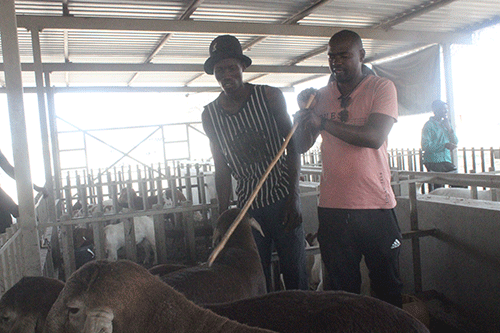OKAKARARA – Commercial and communal farmers from various parts of the country, who came to showcase their animals and different products at the Okakarara Annual Trade Fair, all hailed the impact and importance of the annual show.
The Okakarara Trade Fair, which is regarded as the country’s second biggest trade fair after the Ongwediva Annual Trade Fair, officially started yesterday and saw large and small-scale farmers as well as various businesses all exhibiting their products and services.
AgriToday caught up with young farmer Tjuu Kaunatjike, who came from Epukiro to showcase his stud Meatmaster rams at the show.
Not only did he bring his well-maintained Meatmasters, but he also came to share knowledge and expertise with fellow young farmers.
“I drove all the way from Otumbonde in the Epukiro constituency to come and showcase the Meatmaster rams I farm with. Platforms such as the Okakarara Annual Trade Fair are very important to young farmers like me and others because this is where we meet to share knowledge and also share solutions to the challenges we face as farmers. Although I have attended other similar shows, it is my first time here at the Okakarara Annual Trade Fair, and I look forward to the experience,” said Kaunatjike.
The Meatmaster is an indigenous Damara sheep, usually crossed with other sheep breeds. The most common cross is with a Dorper, but many of the first Meatmasters were crossed with breeds such as the Ile de France or the Van Rooy.
The Damara is a tough sheep, recognisable by its long, slender form and thick, fat tail. The Meatmaster is now farmed extensively in Namibia and enjoys tremendous popularity.
It is bred as a non-fat-tailed hair-type sheep for meat production, and it offers farmers an alternative with unique characteristics to meet the needs of the market.
“When you follow the market trends, you will notice that people want top-class meat and the Meatmaster offers exactly just that – top-grade meat. I encourage young farmers to test the waters with the Meatmaster, as it is good value for any customer’s money. You can’t go wrong with this breed, it’s just the best in terms of money in your pocket and the quality of the lambs,” advised Kaunatjike.
Another farmer Lenni Kasiringua of Ouua ua Tjozongombe farming in the Otjituuo area, also hailed the impact of the trade fair, saying it does not only serve as a platform to showcase one’s products but to also make new connections and learn from others.
Kasiringua farms with both the Damara and Blackhead Persian sheep – and just like Kaunatjike, he too strongly believes in his breeds.
“I have farmed with these breeds for years now, and the results are quite great. Just like the farmers, I came here to showcase what I do, see what the other farmers are farming with and also exchange notes. It’s my third time coming to this trade fair, and the experience has always been wonderful. It’s a big platform for us, communal farmers, as we hardly get such opportunities and exposure. This is also where we get potential clients,” said Kasiringua.
The Blackhead Persian is a fat-tailed breed of domestic sheep from Africa, originally from Somalia and a direct descendant of the Somali sheep. The breed is also a type of hair sheep, meaning they do not grow wool, but they tolerate heat better than wooled breeds. They are raised primarily for meat.
Meanwhile, the Damara sheep is a Namibian breed of fat-tailed hair sheep, also found in South Africa. The name derives from that area in Namibia, where the Damaran reside, particularly in the Kaokoveld Desert.– ohembapu@nepc.com.na


